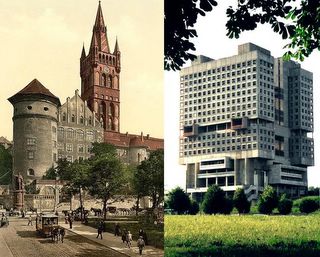Die versunkene Stadt

I received a biography of Herder this week (you can also buy books dirt cheap from secondary sellers on Amazon in Germany), which was touchingly wrapped in a beautiful full-page article on Königsberg ("The Lost City") from Die Zeit. It went something like this...
"Königsberg is the capital of the kingdom of Prussia, and one of the biggest, richest, and most beautiful cities in Europe...," so begins an entry in (the) Zedler, the great encyclopedia of the German enlightenment. It is only a lexicon article, but it reads like a declaration of love, an homage to the spirit of a city that disappeared in the years after 1945. One that lives on today, 750 years after its founding, in a new raiment and considered under the name of a Russian revolutionary (and eventual Stalinist functionary): Mikhail Kalinin.
Sometime in the 1920’s the Prussian Minister of Agriculture met two farmers on his first official journey to Königsberg. "I’m in East Prussia for the first time," he admitted, somewhat intimidated, "What do I absolutely have to know?" The answer: "First you have to know the stallion Tempelhüter. Second you have to know the Bulle Anton. Third you must know Kant." Then after a while, "If beyond that you know the stallion Pythagoras, you needn’t bother with Kant at all."

Well, that’s about as far as I got...but I did manage to find out that Tempelhüter (temple guardian) was from the famous Trakehner Stables, which now look like this. The Bulle Anton was more elusive.

Königsberg ("King's Mountain") was an East Prussian port on the Baltic (ice-free year round!). Founded in 1255 by the Teutonic Knights (in the Christianization/conquest known as the Northern crusades), it ended up in the hands of the Hohenzollerns a few hundred years later...and remained so until WWI. After that it was cut off from the rest of Germany by the Polish corridor, but the Nazis took care of that.

South of the city near Rastenburg, in what is now Poland, is the popular tourist attraction Wolfsschanze. It was here, in a complex of bunkers that served as a military headquarters, that Colonel von Stauffenberg’s failed attempt on Hitler’s life took place. The bomb was sufficient enough to lift the six foot thick, reinforced concrete roof, but Hitler lived. Stauffenberg was dead within 24 hours, as were many of his co-conspirators...including one who, oddly enough, has a department store named after him in the main square here in Munich (actually, I believe the name is coincidental...but isn't Ludwig Beck am Rathauseck--lootvik beck ahm raht house eck--catchy?). Just to the north is the town of Nidden, where Thomas Mann built a summer house in the early thirties. The locals used to refer to it as Uncle Tom’s Cabin. It was commandeered and used as a hunting lodge by the Nazis (who took possession of many very valuable first editions in the bargain), and is now a bed and breakfast ("Gästehaus Elchwald"...the Moose Forest Guesthouse).

Kaliningrad now belongs to the Russians, who tore down the castle of Königsberg (above, left) in the late sixties—as it was seen to be a symbol of Prussian militarism and fascism, they obviously preferred their own brand—and replaced it with the "House of the Soviets." Well, they tried to replace it anyway, construction stopped in 1980 due to lack of funds.

<< Home